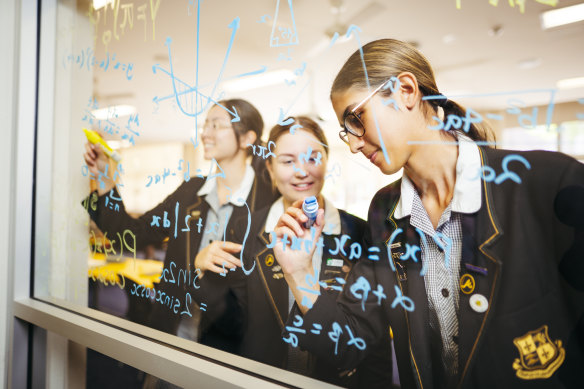About 40 per cent of Australian teenagers do not feel confident calculating the cost of a computer with added tax after a decade of worsening “mathematics anxiety” that educators say has been exacerbated by faddish teaching methods shunning the importance of basics such as times tables.
A new international report says 15-year-old Australian students are more likely to feel helpless, nervous and “very tense” when they attempt numerical calculations compared to 2012.

Students who enjoy the maths and feel comfortable in the subject perform better, the report said.Credit: Dion Georgopoulos
Australian girls were more likely to express anxious feelings about solving mathematical problems when compared to boys, even if they were top performers in the subject.
Stereotyped attitudes towards mathematics may be behind the gender difference observed around the world, the report from the OECD said, with boys more likely to report having a growth mindset in the subject than girls by an average of 7 percentage points.
Mathematics anxiety, the name given to the feeling of being overwhelmed and confused when faced with a numerical problem, has been rising in almost every country over the past decade.
The report, based on data from the Programme for International Student Assessment from 2022, states that a one-point increase in the mathematics anxiety index is associated with a decrease in mathematics achievement of 18 score points.
“Students who are more confident and students who are less anxious ask more questions when they do not understand something being taught,” the report said.
Another OECD report from last week noted Australian girls’ higher rates of anxiety were mirrored by other English-speaking countries.
“While attitudes across society are difficult to capture and are not monolithic, studies have suggested that there is a prevailing perception in many Western countries that associates mathematics with being difficult, cold and abstract,” it said.
Thailand, Singapore and Korea were the only countries to see a decrease in maths anxiety over the period.
Mathematics researcher Dr Greg Ashman said English-speaking countries had focused on teaching “problem-solving skills” and eschewed remembering procedures such as long division or memorising times tables – which he said was “fundamentally wrong”.
“Evidence suggests that teachers in East Asia want their students to understand maths just like we do. However, they also appreciate the fundamental importance of practising facts and procedures to fluency. Without this fluency, there is no strong foundation. Students are presented with problems they struggle to solve and this is what plausibly drives maths anxiety.
“When it comes to the gender gap, there are other factors at work, many of which are complex. However, if we taught maths better – if we taught it clearly and explicitly and asked students to practise to fluency – we may reduce the aversion to maths felt by some girls because they would experience more success as a result of this better teaching.”
Centre for Independent Studies policy researcher Kelly Norris said: “They don’t feel successful in maths and they get low self-esteem, which leads to avoidance, which leads to less practice and ... more anxiety.”
Start the day with a summary of the day’s most important and interesting stories, analysis and insights. Sign up for our Morning Edition newsletter.